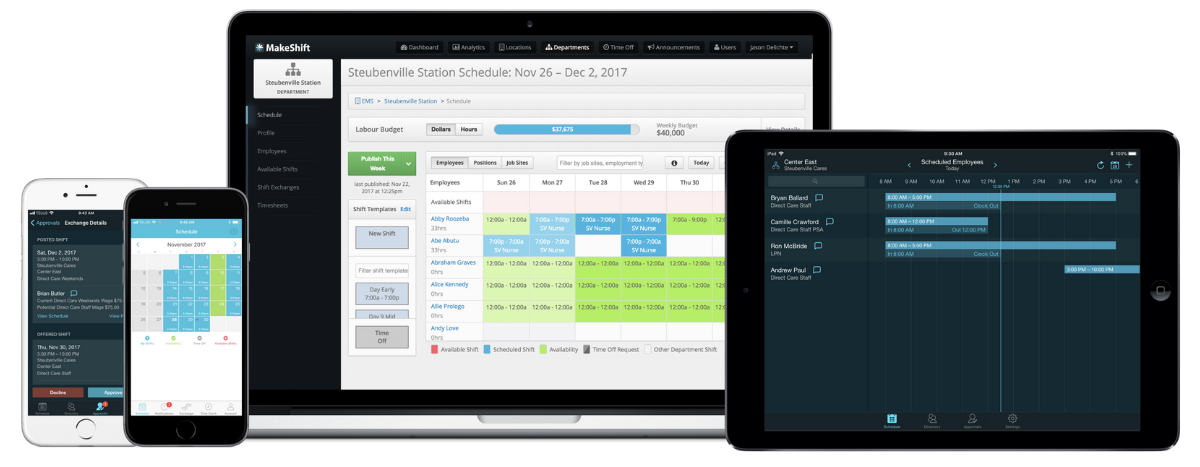Nursing has come a long way.
From the early days of nursing, when it was seen as a low-paying, menial job, to today, where nurses are highly respected professionals.
Nurses have become essential to the healthcare system, serving as critical members of healthcare teams and often taking on leadership roles.
Knowing the latest nursing statistics is essential because they highlight ongoing challenges facing the profession.
These challenges include nursing shortages, high turnover rates, and burnout, impacting patient care and the healthcare system.
Relevant nursing statistics can help you address these challenges to ensure nurses can continue providing high-quality care to their patients and contribute to advancing healthcare.
We’ve compiled a list of today’s top nursing statistics to give you the knowledge you need to support your nursing staff.
- Nursing Has Come a Long Way
- Nursing Statistics You Should Know
- How Better Staff Scheduling Helps Nurses
- Smarter Nurse Scheduling is the Future
Nursing Has Come a Long Way
The nursing profession as it’s known today dates back to the 18th and 19th centuries.
In general, nursing has gone from an extension of traditional caretaking to full-blown clinical practice. Modern nursing now requires nurses to go through extensive formal training and certification.
With this transition came the need for formal education and training — accelerated by multiple wars in which female nurses provided desperately needed care to save countless lives.
Florence Nightingale — The Lady With the Lamp
We can’t talk about the evolution of nursing without addressing Florence Nightingale’s work during the Crimean War.
Florence shocked her wealthy parents by casting off high society life to become a nurse.
She demonstrated the value of nurses and the need for strict sanitation practices — practices that were unheard of before she came into the picture.
She and dozens of volunteers were sent to poorly maintained military hospitals by Secretary of War Sidney Herbert in response to shocking stories of inhumane conditions.
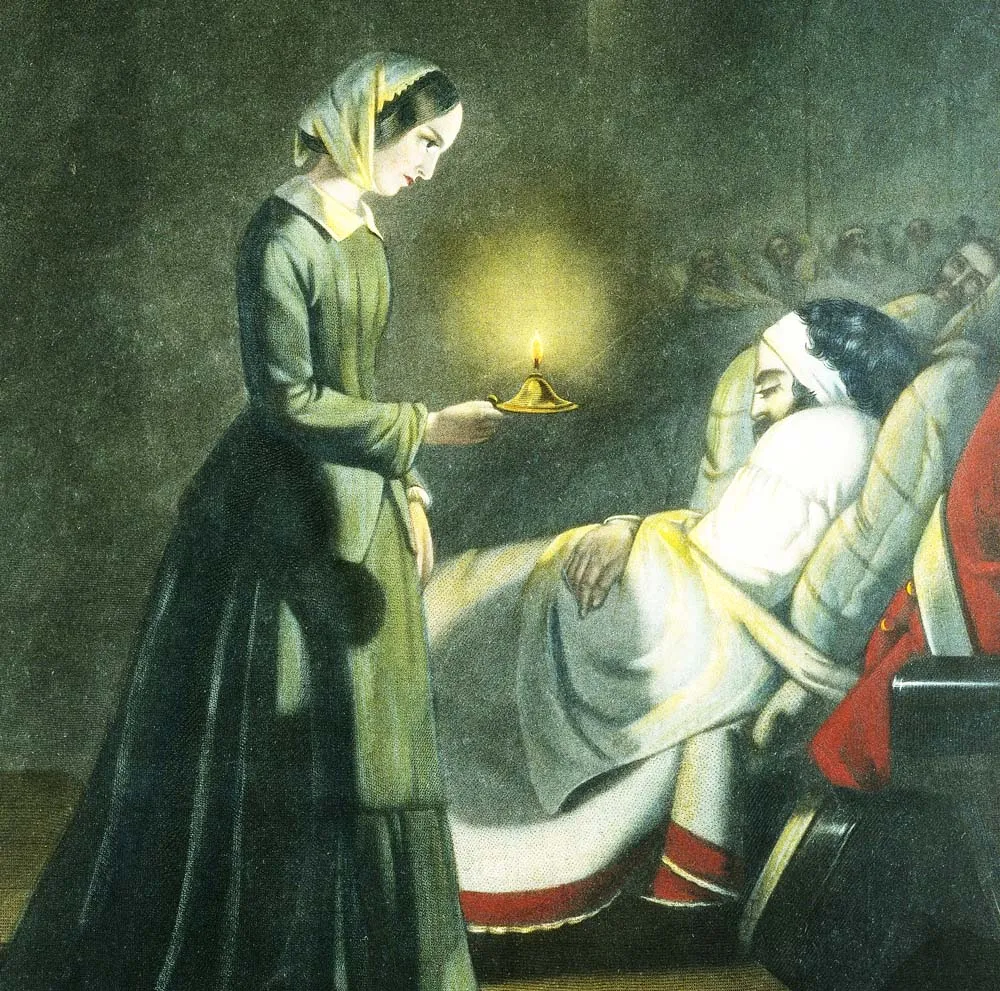
Known as the “Lady with the Lamp,” Nightingale helped reduce the death rate in Crimean military hospitals by 2/3.
Yep, you read that right — 2 out of 3 people lived because of practices she put into place.
Today, she’s widely known as the founder of modern nursing.
The Evolution of Nursing Education
After dear Florence gave nurses serious street cred in the Crimean War, which wrapped up in 1856, it was apparent nurses needed formal education.
In 1873, the 1st nursing schools opened in the U.S. and Canada in 1874.
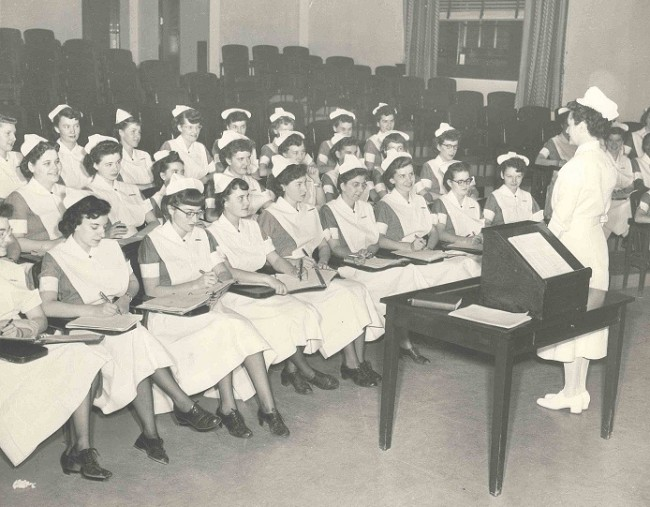
Nursing developed into a profession — however, nursing education had a rep for being chaotic.
In the U.S., The National League of Nursing Education (NLNE) was 1st formed in 1893 as The American Society of Superintendents of Training Schools for Nurses.
They had 3 goals:
- Higher minimum entrance requirements.
- Improve the living and working conditions for nursing students.
- Increase opportunities for post-graduate and specialized training.
The NLNE was highly influential in the early 1900s in leveling up nursing education and the profession as a whole.
During the 2nd half of the 20th century, nurses began to take on a broader range of clinical responsibilities. This called for more extensive training and stringent requirements for licensing.
By 1947, NLNE’s board had a goal of moving nursing schools to the higher education system.
Soon, 2 and 3-year associates and bachelor's degrees were available.
Nursing education developments in the 1980s, 90s, and early 2000s mainly focused on the creation of new graduate programs targeted at advanced practice nursing and nurse practitioners.
Today, many RNs are encouraged to get their Masters to prep them for leadership in the field.
Nursing has come a long way — let’s take a look at today’s statistics in the profession.
Nursing Statistics You Should Know
If you're in the nursing field, you’ve got to stay on top of the latest stats. They give you the lowdown on the challenges nurses are facing, like staff shortages and burnout, so you can take action and improve your work environment.
Plus, valuable stats can help you provide the best care for your patients. Keeping up with the latest nursing stats is a must if you want to keep crushing it in the field.
Nursing Demographics
Nursing demographics are crucial to ensure you know and understand your nursing workforce.
- Men represent 9.4% of RNs and 8.1% of the LPN/LVN workforce are men.
- 42% of RNs started their nursing career with a Bachelor’s degree.
- The number of male nurses has tripled over the past 50 years.

- The number of RN jobs will grow by 6% from 2021 to 2030.
- Hospitals are the primary employment setting for 54.8% of RNs.
U.S. Nursing Statistics
Let’s drill down further to what’s going on with U.S. nurses today — how many nurses are working, and where are they most needed?
- Today, there are approximately 4.2 million registered nurses and over 325,000 licensed nurse practitioners
- California tops the list of nurse shortages with 44,500 less than they need (behind CA are Texas, New Jersey & South Carolina, all lacking about 10,000 nurses)

- As of today, there are approximately 155,000 annual RN graduates.
- The median pre-tax earnings for RNs is $82,750.
- The highest-paid RNs are in California at $124,000.00.
- The median annual salary for LPN/LVN is $51,850.
- The highest paid LPN/LVNs are in Alaska at $67,620.
- The average age of RNs in the U.S. is 52.
- There are about 11.7 nurses per 1000 people - roughly 1.17%.
- Currently, California and Massachusetts are the only U.S. states that have laws mandating nurse-to-patient ratios.
Canadian Nursing Statistics
What’s going on with Canadian nurses? Check out where they’re most needed and what kind of money they’re making.- Today, there are roughly 312,382 registered nurses and 7,400 nurse practitioners
- Ontario, Alberta & British Columbia make up over 60% of the total demand for nurses in Canada.

- 12,780 students graduated from entry-to-practice programs for registered nurses in 2021.
- The average pre-tax earning for a Canadian RN is $72,874.
- The highest-paid RNs are in Alberta at $89,972.00.
- The median annual income for LPN is $56,548.
- The highest-paid LPNs are in Saskatchewan & their annual income ranges between $61,406 - $62,961.
- The average age of a Canadian RN is 43.
- Ontario has only 669 RNs per 100,000 (1 to 149) people compared to 828 RNs per 100,000 (1 to 120)people across the rest of Canada.
- Nurses in Canada - 10.94 per 1000 people - roughly 1.09% of the population
Nursing Student Stats
Nursing students today face unique challenges, from the stresses of distance learning to the increased demand for quality care in a rapidly evolving healthcare industry.
After learning about the evolution of the nursing profession and education, let’s take a look at what’s happening in education now.
- 65.2% of RNs have earned a Bachelor of Science in Nursing (BSN) degree, while 1.4% have earned a Doctor of Nursing Practice (DNP) degree.
- Within 4 to 6 months of completing their programs, 94% of BSN graduates and 92% of MSN graduates have secured job offers.
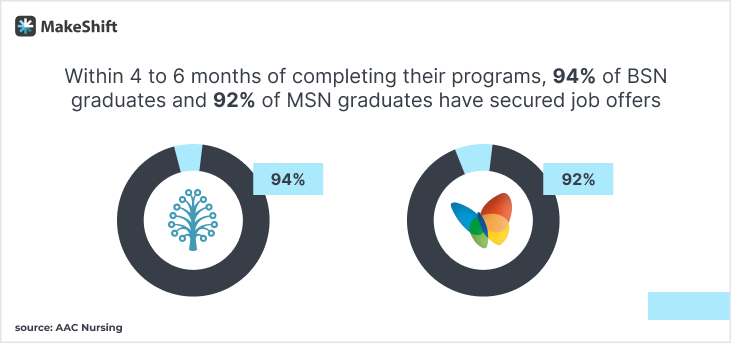
- A BSN is now required for new hires by 41% of healthcare employers and strongly preferred by 82% of employers.
- In 2020, more than 36,000 people graduated from nurse practitioner programs.
- Student enrollment in entry-level baccalaureate nursing programs increased by 3.3% in 2021.
- Enrollment in Doctor of Nursing Practice (DNP) programs jumped by 4.0% in 2021.
- Unfortunately, enrollment in Ph.D. nursing programs has continued to decline, with a 0.7% decrease (32 fewer students) from 2020 to 2021.
- The Nursing Education Loan Repayment Program repays up to 85% of educational loans for nurses who work in qualifying facilities with critical nursing shortages.
Fascinating Nursing Facts
“How can anybody hate nurses? Nobody hates nurses. The only time you hate a nurse is when they’re giving you an enema.” — Warren Beatty
You already know how awesome nurses are (and we 2nd that) — we’ve found a few facts to reinforce that.
- Nursing is considered the most honest and ethical profession in the United States. Every year, Gallup asks U.S. adults to rate the honesty and ethics of a number of professions. And for a whopping 18 years in a row, Americans rate nurses as the most honest and ethical by a landslide. Nurses beat out engineers, doctors, pharmacists, police officers, psychiatrists, and even clergy, for the #1 spot.

- Nurses walk an average of 4 to 5 miles in a 12-hour shift. Let’s put that in perspective — the average American adult only walks 2.5 to 3 miles over the course of an 18-hour day.
- There are 4x as many nurses in the U.S. as there are physicians.
Nursing Home Nurse Statistics
These nursing home statistics can help in providing the best care and quality of life for residents and improving the work environment for your nurses.
- For patients, this info can help them choose a nursing home that meets their needs and preferences.
- For nurses, it can help them provide better care by analyzing trends and developing personalized care plans.
Ultimately, these statistics help ensure that patients receive the best possible care and that nurses have the resources they need to provide it.
- 94% of nursing homes face staffing shortages.
- Nursing homes have lost nearly 229,000 caregivers (more than 14% of their workforce) since February 2020.
%20since%20February%202020.png?width=732&height=251&name=Nursing%20homes%20have%20lost%20nearly%20229%2c000%20caregivers%20(more%20than%2014%25%20of%20its%20workforce)%20since%20February%202020.png)
- In Washington, 10% of patients currently in hospital beds are waiting for a spot at a nursing home or mental health facility, according to the Washington State Hospital.
- 1 in 5 workers (21.8%) in this industry are either RNs or LPNs.
Nursing Home staff turnover is over 50%.
Nurse Retention Statistics
We all know that keeping nurses is getting tougher by the day. It’s essential to increase your staff retention.
A good staff retention rate boosts employee morale, improves patient care, and keeps your healthcare facility running like a well-oiled machine.
- In 2021, the turnover rate for staff RNs jumped by 8.4%, making the national average 27.1%.
- Over the last 5 years, specialized RN departments had a cumulative turnover rate between 101.3% and 111.4%. Essentially, every 5 years, these departments will turn over their entire RN staff.
- More than 1/3 (34%) of nurses say they’ll likely leave their jobs soon.
- The average cost of turnover for a bedside RN is $40,038. Each 1% change in RN turnover either costs or saves the average hospital $270,800 annually.
Burnout and Fatigue Nurse Statistics
It's no secret that burnout and fatigue can take a toll on nurses. It can cause nurses to feel overwhelmed and unable to cope with the demands of their job.
Fatigue can lead to errors in judgment, decreased job satisfaction, and a lack of focus and concentration, which can impact patient care.
Burnout and fatigue can impact nurses’ family lives — they don’t get to see their kids enough or are too tired to enjoy their family when they’re home.
- 95% of nurses felt burned out at some point during the last 3 years.
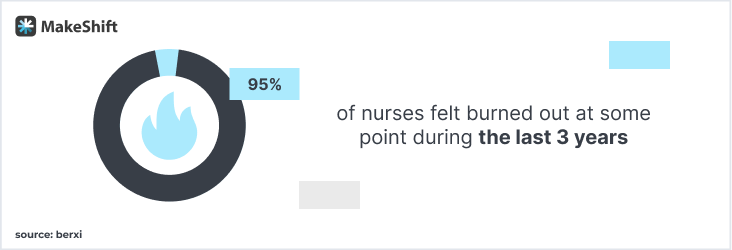
- Low staffing, emotional exhaustion, high workload demands, workplace morale, and lack of respect were the top 5 reasons contributing to nurse burnout.
- 27% did not feel comfortable bringing the issue up to management.
- 85% of nurses experience career fatigue.
- Burnout can lead to compassion fatigue (40%), where nurses struggle to empathize with patients.
- 98% of hospital nurses report that their work is physically and mentally demanding — 85% of nurses report these demands are making them feel fatigued.
Nurse Injuries
Unfortunately, nurses are prone to injuries in the workplace because of the physical demands of their profession.
Burnout and fatigue can also lead to an increased risk of injury due to decreased physical strength and coordination.
Common injuries include back pain, falls, and musculoskeletal issues.
- In 2019, RNs experienced 20,150 incidences of nonfatal injuries or illnesses.
- Registered nurses experienced more workplace injuries than construction workers in 2019.
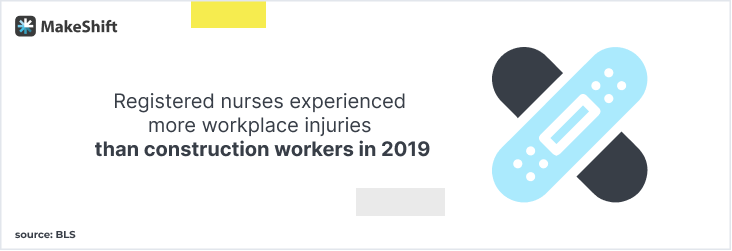
- Nurses ages 45 to 54 accounted for 27% of all injuries and illnesses.
- Violence and other injuries by people or animals accounted for about 12.2% of all cases.
- 18.4% of nurse injuries are falling or slips.
Labor Shortages
The nursing shortage significantly impacts the healthcare system — it can lead to decreased access to care and lower quality of care for patients.
Nurses play a critical role in delivering care and are often responsible for coordinating patient care across different providers and settings.
When there aren’t enough nurses available to meet the needs of patients, this can lead to longer wait times, increased workload and stress for the remaining nursing staff, and a higher risk of medical errors.
- 1.1 million nurses are needed to address the current nursing shortage.
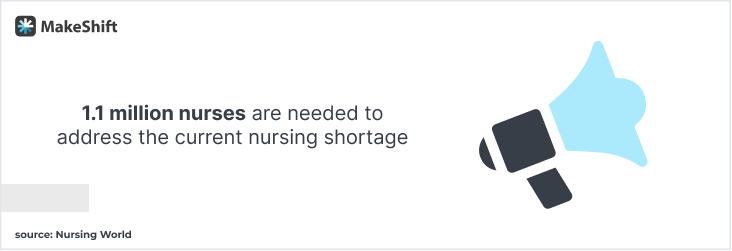
- More than 85% of California hospitals report that demand for RNs is greater than supply.
- More than 1/5 of all nurses plan to retire within the next 5 years.
- In 2021, U.S. nursing schools turned away more than 91,000 qualified applicants due to a lack of faculty, education space, and resources.
- The nursing shortage is attributed to a large number of nurses reaching retirement age AND younger nurses fleeing the industry due to burnout.
Nurse Scheduling and Workload Statistics
For most nurses, no 2 work shifts are alike. All shifts require healthy recovery time, but some situations call for more rest between shifts than others.
That’s just 1 of many challenges nursing managers face in crafting schedules flexible enough to meet the needs of staff while ensuring an adequate level of patient care.
Scheduling problems are a top contributor to burnout and lower job satisfaction. In particular, mandatory overtime has been associated with increased levels of nurse burnout.
When it comes to creating your nurses’ schedule — take note of these statistics:
- New nurses prefer to work 12-hour shifts rather than 8-hour shifts.
- Most nurses choose a day shift over working nights.
- 45.6% of new nurses work voluntary overtime, averaging 3 hours per week.
- Nurses whose workload is above optimal levels are 10% to 30% more likely to be involved in a patient safety incident and 40% more likely to experience patient mortality.
- 89% of nurses say their organization is currently experiencing a staffing shortage
- 94% of nurse managers believe scheduling woes hurt nurse morale.
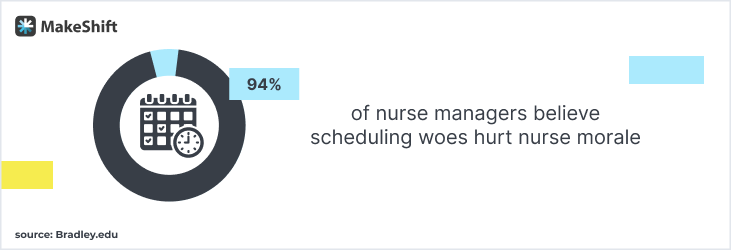
- 70% of nurse managers believe understaffing impacts the patient experience.
- 80% of nurse managers aren’t aware of advanced scheduling technology & 43% have access to automated scheduling but still schedule manually.
How Better Staff Scheduling Helps Nurses
The nurse scheduling dilemma is a delicate, not to mention critical, balancing act that weighs the healthcare organization’s need for sufficient staffing to provide quality care against the health and well-being of nursing staff.
A better staff scheduling solution helps nurse leaders combat many of the negative statistics above.
In August 2021, nurse leaders cited the statistics below as their top challenges related to scheduling:
- Emotional health and well-being of staff — 75%
- Surge staffing, training, and relocation — 61%
- Staff retention, furloughs, and layoffs — 47%
- Communicating & implementing policy changes — 34%
3 Benefits of Streamlined Scheduling
Streamlined staff scheduling helps nurses manage their shifts more efficiently and cost-effectively. It can reduce nurse fatigue, burnout, and overtime costs, as well as improve patient satisfaction.
3 benefits of streamlined staff scheduling are:
1. Improved Efficiency — An efficient scheduling system reduces scheduling errors and positively impacts your staff and healthcare facility. Improved scheduling efficiency results in:- Reduction of Overtime
- Improved Patient Care
2. More Job Satisfaction — Streamlined scheduling makes your nurses happier and more satisfied with their work life. Increased job satisfaction comes from:
- Improved Work-Life Balance
- Higher Retention
3. Better Team Communication — Streamlined scheduling includes better communication channels. And better communication offers:
- Easier access to schedules
- Push team notifications that keep your team up to date
Smarter Nurse Scheduling is the Future
Healthcare environments like hospitals are fast-paced and change on the fly. They face the challenge of operating 24/7.
Many nurses are scheduled on rotations, and shift callouts are heavily used to bring in more staff in times of need.
Ease the burden of your nurse scheduling by ditching manual scheduling — schedule smarter and more efficiently with MakeShift.
Nurse-Specific Features
- Available Shifts
- Skills-Based Scheduling
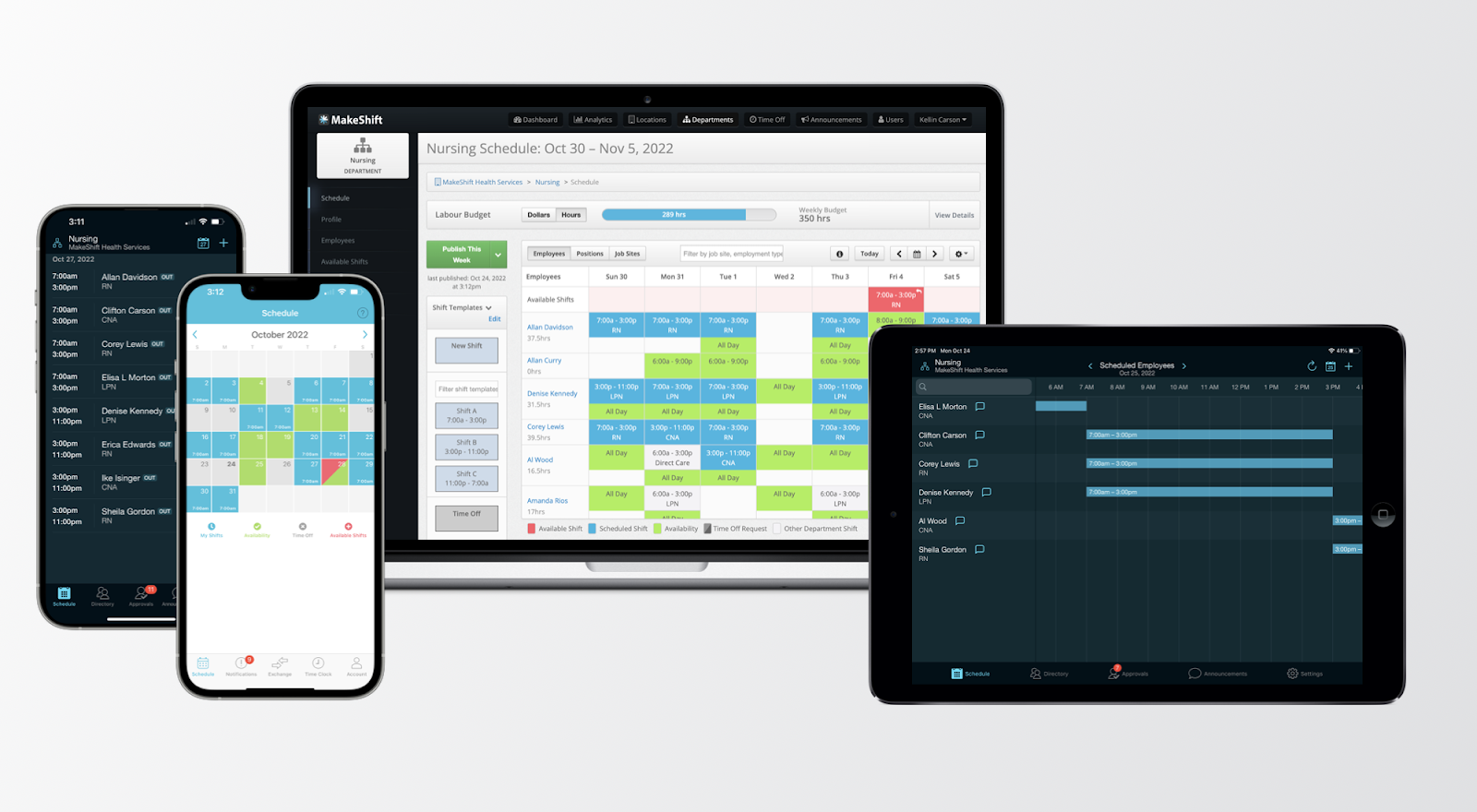
- Employee Shift Swapping
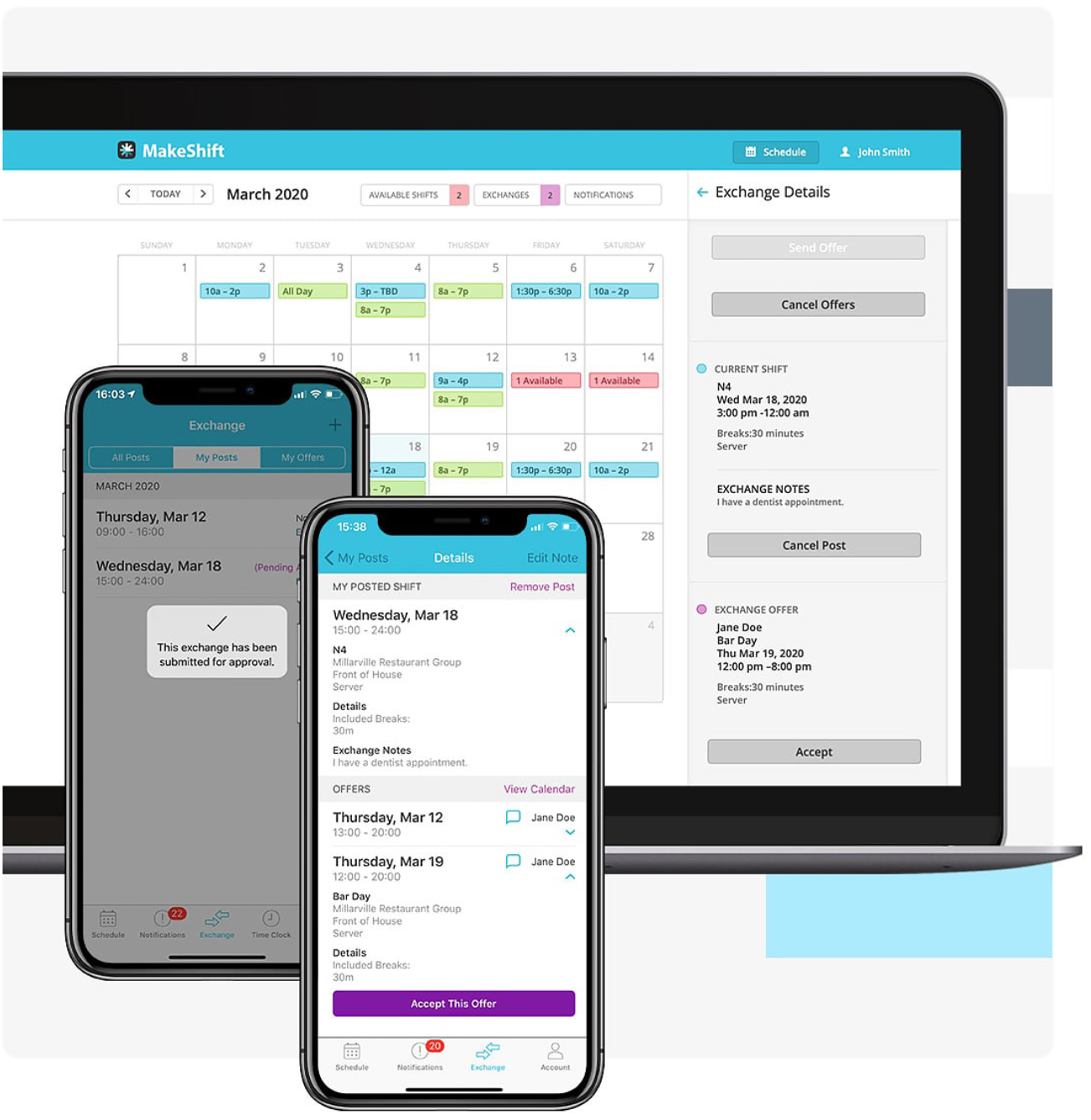
- Time Off / Leave Management
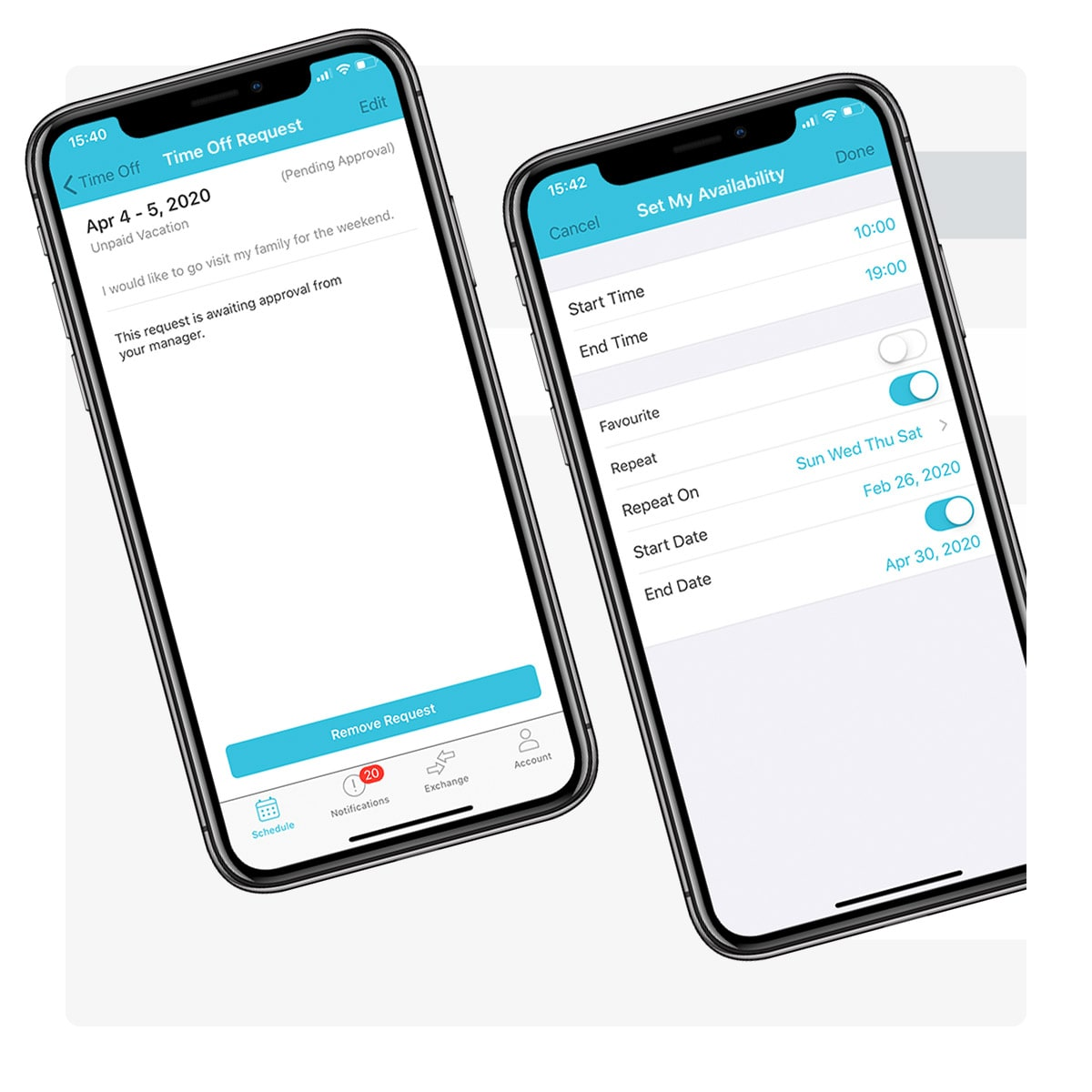
- Fatigue Management Rules
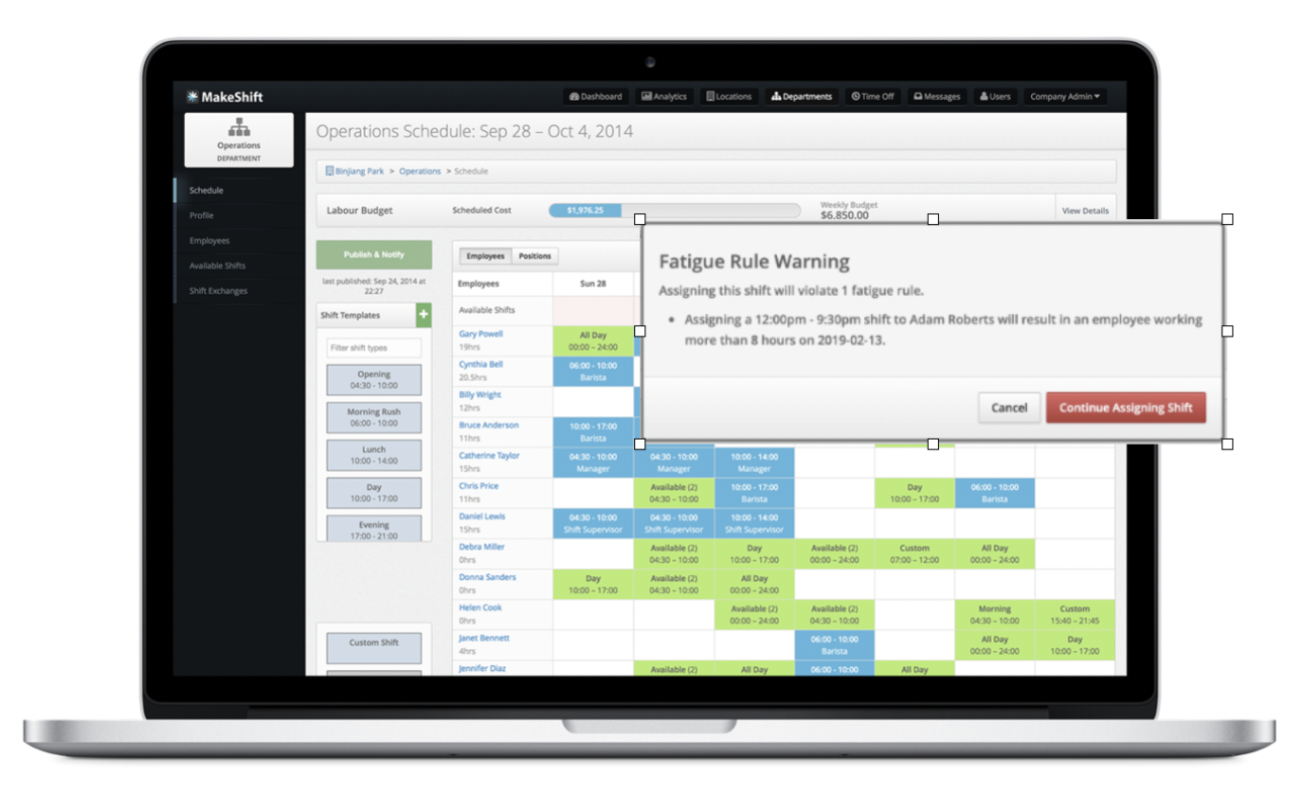
- Team Communication for Schedule Changes
Stay Ahead by Knowing Nursing Statistics
The nursing profession is fast-paced, with on-the-fly changes that require skill, focus, and a level head.
Being armed with relevant statistics helps you stay up to date on what’s happening in the healthcare industry today.
You can help your nurses and ensure quality patient care when you're in the know.
At MakeShift, our people-first approach helps you stay ahead of the rapid changes in the healthcare industry and take great care of your nurses.
Request a free demo today to elevate your nurse scheduling process.




